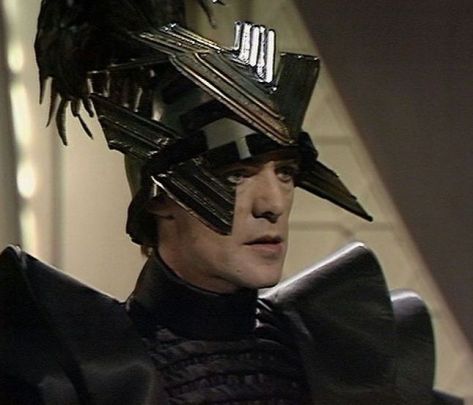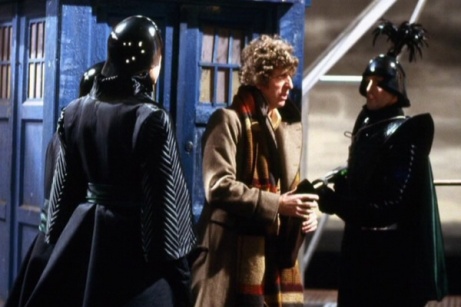With The Horns of Nimon, Graham Williams’ (televised) tenure as producer ended with something of a whimper rather than the bang he intended.
Williams had budgeted two cheaper stories (Nightmare of Eden & Nimon) in order to lavish a generous amount of location filming on the season finale, Shada. But Shada was never completed due to industrial action, which was the final piece of bad luck to befall Williams on Doctor Who.
Even before this though, Williams had more than his fair share of problems to deal with. The late 1970’s was a bad time to be a Doctor Who producer – hyper inflation meant that year on year the show’s budget was shrinking, industrial action was a constant threat and Tom Baker was proving to be more of a handful than ever.
Nimon is rated 223 of out 241 stories in DWM’s 2014 poll. So it’s very much down amongst the also-rans, rubbing shoulders with similarly unloved stories such as Arc of Infinity, Warriors of the Deep and The Time Monster. But whilst nobody in their right mind would call Nimon an overlooked classic, it does have some good points which go some way to balance out the numerous production mis-steps.
On the credit side, Tom Baker is still coming up with the goods. Six years in, there’s no doubt that he’s done all of this stuff hundreds of times before but he still manages to make it seem fresh. Whatever his thoughts about poor scripts and his off-screen spats with Williams, on-screen he’s focused and giving it 100%. And he does have the odd gem, such as –
Nimon: “Later, you will be questioned, tortured and killed”
The Doctor: “Well, I hope you get it in the right order”
Lalla Ward is equally good value as Romana. Separated from the Doctor for an episode or so she effectively becomes a surrogate Doctor and manages to effortlessly carry the narrative. Forget K9 & Company, a spin-off with Lalla and K9 was a huge missed opportunity.

As for the guest cast, a mixed bag is the kindest way to describe them. Simon Gipps-Kent and Janet Ellis are really just the Babes in the Wood – and their characters are so under-written that they aren’t called on to do much acting.
Malcolm Terris is pretty poor as the Co-Pilot which is summed up by his final scene as he faces the wrath of the Nimon and his trousers fail to take the strain. Elsewhere on Skonnos, Sorak (Michael Osborne) and Soldeed (Graham Crowden) are an odd couple, to put it mildly.

Osborne plays it dead straight, which is all the more impressive when you consider his costume. Crowden, on the other hand, gives a performance that is on another planet to everybody else – even managing the impressive feat of making Tom look like an actor of great restraint.
Much has been written about Crowden’s turn as Soldeed and it’s the sort of performance that you either love or hate. Frankly, I love it as Nimon is the wrong story for too much naturalistic acting. But as some people have never liked Doctor Who to be fun it’s no surprise that many either don’t get the joke or consider it to be out of place.

But amongst the under-acting, over-acting and no-acting, there is one perfectly pitched performance – John Bailey as Sezom. Bailey had previously appeared as the doomed Waterfield in The Evil of the Daleks (1967) and there’s a similar vibe to this character. It’s only a small part, but Bailey is excellent and it’s one of the highlights of the story.
As for the Nimon, oh dear. The Williams era is notable for a run of underwhelming monsters (immediately prior to this viewers would have been reeling from the glowing green bag that was Erato and the less-than-terrifying Mandrels) so the Nimon are pretty much business as usual. And as soon as the first one stumbles onto screen in his platform heels you know it isn’t going to end well.

The Horns of Nimon was the end of an era in many ways. When the series returned it would feel quite different with a much more serious tone to proceedings. But everything is cyclical and there would eventually be heirs to Crowdens throne (Paul Darrow in Timelash for example).
But for the moment, Nimon is the last gasp for this kind of goofy Doctor Who. Full of faults yes, but anything with Tom Baker, Lalla Ward and Graham Crowden can’t be all bad.

I really enjoyed reading your thoughts on this one. I agree that this story is more enjoyable than its reputation suggests and I also have no problem with Crowden’s performance. There is no excusing the way the Nimon were realized though. Perhaps if they actually looked more scary and bull-like people would have had a higher impression of this one…
LikeLiked by 1 person
Yes, the Nimons just don’t work. It’s hard to take any monster seriously when they are staggering about on heels that size. And the mask is another problem – since it looks too obviously like a mask.
The days of impressive monster sculpts like the Draconians, Linx and the Zygons seem to be a long way away at this time, sadly.
Crowden’s fab and I’ve always enjoyed some of his more off-kilter performances, such as the Groper in the Callan episode “A Village Called G”.
Whatever else Nimon is, it isn’t dull and like the rest of S17 I’m impressed just how watchable it all is.
LikeLike
Two years late
This episode isn’t quite so bad it’s funny, due to Crowden’s tongue in cheek performance but I enjoy it nonetheless.
If MST3K were to cover TV episodes, I think this would be a good choice for Joel/Mike and the bots to cover.
LikeLike
The BBC was short of money in the late seventies, the surge in colour television licences that saw a boom in funding in the early and mid seventies had come to an end, inflation was eating into the licence fee, and this was starting to show in some of their programmes. Some of ITV’s biggest dramas were being filmed totally on location, which made them look far more modern and professional, while the BBC was still relying on studio bound programmes. This did show in Doctor Who as the seventies went on, there was far more location filming in the Pertwee era than the later Baker stories, where some episodes were done completely in a studio.
LikeLiked by 1 person
You have to feel sorry for Graham Williams. Galloping inflation during the late seventies meant that in real terms Who’s budget didn’t stretch nearly as far as it did when Philip Hinchcliffe was producer.
Also, Hinchcliffe was notorious for overspending, something which the BBC executives were no longer prepared to countenance – but it was Williams who suffered under this stricture.
So he had to juggle his budgets in order to get the best results. For S17, two cheap all-studio stories (Eden, Nimon) were recorded, which meant that more funds could be channelled into the season closer, Shada.
Poor Williams. He rarely had any luck ….
LikeLike
Then, of course, Shada was never completed due to industrial action, a curse on both the BBC and ITV in the late seventies, although the BBC never had to endure the ten week shutdown ITV endured in 1979.
Also the ITV strike coincided with the highest ever ratings for a Doctor Who story, the decent City of Death, with its location filming in Paris and a cameo by John Cleese. Then everyone nearly fainted when Scaroth removed his mask to reveal a face full of maggots. Probably the best of the later Doctor Who stories and one where the budget was spent well.
LikeLike